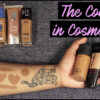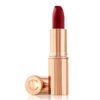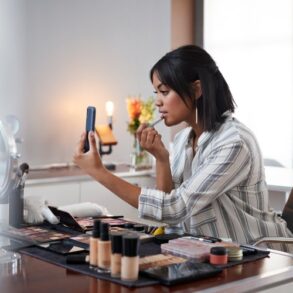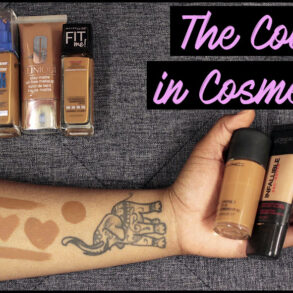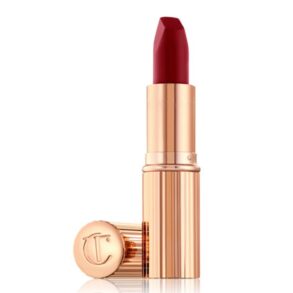In a way, when environmental researcher Ami Zota looks at data about patterns of cosmetics use by women of color in 2023, she’s gazing back in time.
There were the fledgling days of the environmental justice movement in the 1980s, when activists began placing a name on the discriminatory ecological practices that adversely affect communities of color. There was the lax regulation of beauty products, guidelines that were first brought under the purview of the Food and Drug Administration in the 1930s and that critics say have undergone too few updates in the decades since. And, looking back even further, there was the antebellum period when racialized notions of beauty—from hair texture to skin tone to body odor—were formally codified by captors of the enslaved.
To Zota, an associate professor of environmental health sciences at Columbia University, each of those precedents has resulted today in what she calls the “environmental injustice of beauty”—the pressure that women of color feel to conform to Eurocentric beauty norms, which compels them to purchase cosmetics at higher rates than women of other backgrounds. That, in turn, places women of color at greater risk for the negative health effects of the potentially harmful substances in products that are largely unregulated.
Earlier this year, Zota co-authored a study that examined the use of products marketed to consumers of color and found that the risks of harm from substances such as phthalates (which have been found to harm the reproductive systems of some animals), parabens in chemical straighteners such as perms and relaxers and mercury (which can cause kidney and nervous system damage) in skin lighteners represents “a growing public health concern.” She is co-director of the community engagement core at the Columbia Center for Environmental Health and Justice in Northern Manhattan.
Her work also takes note of the impact of the beauty industry on the planet’s climate, which already finds itself challenged by such chemicals as perfluorinated alkylated substances, or PFAS (say it: pea-fass), which do not degrade easily in the environment—an attribute that has led to their nickname: “forever chemicals.”
Some of those forever chemicals, which have contaminated nearly half of the nation’s water supplies, are also found in beauty products. It’s another part of a toxic circle: in addition to higher levels of forever chemicals in the drinking water of communities of color, beauty products marketed to people of color often contain the substances.
“They add PFAS because it has water-resistant properties,” Zota said of cosmetics manufacturers. “So it can be found in products that are long-lasting like mascara, foundation and some kinds of lipsticks. So it’s an exposure. But then you think about it: when you wash the products off your face, it goes right into the water.”
Or into the skin.
Recently, she spoke to Inside Climate News at her office on Columbia’s campus about her work.
This interview has been edited for clarity and length.
Before you started looking into the harms of beauty products, you were studying breast cancer as an environmental justice issue?
Yes. It was based on Richmond, California, where Chevron is. We were looking at all of these chemicals—a lot of which were hypothesized to come from oil combustion—thinking about Chevron and the polluting industries. At that time I was a post-doc, so I just finished my Ph.D. and the people I worked with also studied these endocrine-disrupting chemicals, the ones that come from products in your homes and building materials. I had a big finding that came out about flame retardants, which are in your couches, in your electronics.
I started working on that and then getting involved in the policy. When I started learning more about these chemicals, I started thinking about the beauty aspect of it. I wrote the first version of a beauty piece, and it was published in 2009 in a newsletter. The first real paper I published was in 2015 with a student; there, we focused on feminine hygiene products. People had already kind of shown that Black women had higher levels of certain beauty product-related chemicals like phthalates and parabens in their bodies compared to white women. We decided to try to figure out if we could and uncover what might be driving that.
We looked at douches, feminine wipes, sprays, tampons, pads, and we found that the practice of douching was associated with higher phthalate levels in your body. The more you’re douching, the higher levels. Statistically, the ratio of ethnic differences and douching explain the differences in phthalate levels.
It kind of connected the dots, but then a lot of the response was, like, “Well, you know douching is discouraged by doctors, right? Why? Why are Black women still doing it?” And a lot of the reporters are almost vilifying the users. Like, “Why are they still doing this practice that isn’t that is not medically necessary?” So it seemed like the social and historical context is really important.
Talk a little bit about the significance of that social and historical context?
I spent a lot of time talking about intersectionality which is the idea that was developed first by Kimberle Crenshaw, who is at Columbia, and is really grounded in Black feminist studies. The whole idea is that there are multiple, interlocking systems of oppression. It’s not additive, it’s multiplicative, right? You can’t can’t separate somebody’s race from their sex, right? So thinking about racism and sexism and the interacting effects of that is different than just racism or sexism. The joint impacts of racism and sexism actually have a long-lasting influence on practices around feminine care, for lack of a better word. And a lot of that also goes back to the time of slavery. Odors around the vagina. They’re considered dirty or bad for everybody, right? So there’s a lot of misogyny. When white slave owners were creating racial categories—which are arbitrary— they were totally created as a way to separate. It had to do with skin color, hair texture features. But they also incorporated scent. Even around the sexual exploitation of enslaved women, scent was also used as a way to legitimize it. There’s all this history. And so there are also these adaptive responses. What’s critical to this conversation of thinking about chemical exposures and health impacts from environmental chemicals is that it has to be done through a structural racism lens because there are many social, cultural, historical factors that drive our beliefs about beauty.
Earlier this year, you collaborated with one of the nation’s oldest environmental justice groups, WE ACT for Environmental Justice, on a study that examined the use of harmful skin lighteners and hair relaxers by people of color in New York City. How did that come about?
The scholarship really resonated with them. We collaborated on helping them collect and analyze data in the communities that they work with because there was no data specific to those communities. And they wanted locally relevant data.
What we really tried to do is really not just characterize what are the uses of chemical hair straighteners and skin whiteners in this population of diverse women and femme-identifying individuals in northern Manhattan, in the South Bronx, but characterize the ubiquity of racialized beauty norms, racist beauty norms and their associations with product use.
That’s something that we’ve talked about in generalities before, but data always helps. One of our big contributions to the literature is really getting at respondents’ perceptions of what others think, which we think is a proxy for societal norms and looking at how that is actually associated. So if a woman responded that others think that people with fair skin are considered more beautiful, you know there was a relationship between those kinds of beliefs and the likelihood of using more skin whiteners.
Skin lightening use has been studied, probably more so in other countries—it’s a globally pervasive practice. And in this country, it’s often immigrant populations that use these products. The population in northern Manhattan, South Bronx is ethnically diverse, culturally diverse, and there’s a big immigrant population. So we were also able to look at who’s using these products by country of origin, by race, ethnicity, etc., which also just adds to the literature around users of these products and potentially high-risk populations.
Your study noted that the use of these harmful beauty products represents “a growing public health concern.” What do you hope will be the main takeaways of this work?
One, that these products are minimally regulated. There’s not much of a safety net when it comes to personal care products. And I think often people assume that if you can find something in a store, it’s gone through a lot of scrutiny for health and safety concerns. But that’s not always the case.
Two, that personal care product use, in some cases, can negatively impact health in a long-term irreversible way.
And then the third part is that users of these products have agency, right? They have the ability to either help create change so that there is a greater market for safer, more affordable products and they can help create change around kind of debunking and dissolving racist beauty norms, especially as they’re passed down from generation to generation. They can also help create change through consumer power.
How does this all relate to climate change?
There is a link because many of these products rely on petrochemicals. And petrochemicals are produced from fossil fuels. So, as there’s more attention around oil and gas, and trying to decrease our dependence on oil and gas, essentially fossil fuel companies are putting more investment into petrochemicals, which then show up as plastics, and trying to increase plastic consumption.
Also, these petrochemicals often get funneled into cosmetics and fashion, so it’s not a coincidence that they’re kind of channeling industries that are women-dominated. But they are related. The fashion industry is another dimension of the pressure to maintain a certain appearance, right along with beauty. Think about cosmetics, think about personal care. The beauty industry is heavily reliant on petrochemicals.
What have regulators had to say about the potential hazards of these beauty products?
The main regulatory statute that governs the health and safety of personal care products and cosmetics was written in the 1930s and is under FDA jurisdiction. But for them, I think it’s like an ancillary kind of thing because their bread and butter is regulation of pharmaceutical drugs. They don’t devote many resources to it, but they also don’t have much authority. And the FDA is very influenced by industry overall. And the trade groups and the industries that are involved in this business are very powerful. And any attempt for a holistic federal reform has not gone far. There’s so few safeguards that most of the industry is literally self-regulated.
Tell Us Your Story
Inside Climate News is reporting on the substances that are contained in beauty, skin care and hair products that are marketed to Black women and other consumers of color and we want to hear from you. Please use the form to share your experience or email Victoria St. Martin, who covers health, climate and environmental justice, at victoria.stmartin@insideclimatenews.org.


